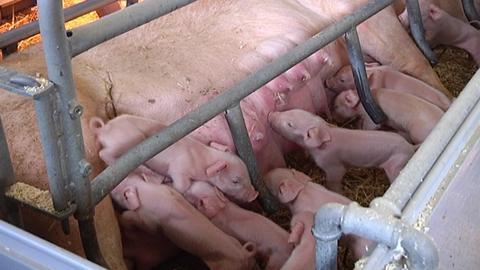
Agricultural News
Bleeding Not Yet Over for Pork Industry, Purdue Economist Says
Tue, 02 Oct 2012 14:34:46 CDT

Purdue University Extension Economist Chris Hurt says pork producers should be prepared to weather the financial storm for at least another six months.
Pork producers are expected to continue to suffer very large losses in the next six months after already operating in the red for the last six months. These large losses have been brought on by the extreme feed prices due to the drought. There is little producers can do to change the overall situation for the industry since the pigs that will represent these large losses are already on-feed. The pigs that are here today represent producers' plans earlier this year when they were hopeful for $5 corn prices.
In the spring of 2012, producers were optimistic that cheap corn was going to arrive by the fall and were expanding the breeding herd. That optimism faded quickly after mid-June when the reality of drought became apparent. The drought turned optimism into fear and producers then shifted to a liquidation mode during late July and August. By early September they had reduced the size of the breeding herd by 74,000 (1.3 percent) compared to the USDA June inventory estimate. In September, weekly sow slaughter estimates indicated a slowing of the liquidation, with sow slaughter only slightly larger than a year ago. Some follow through on sow liquidation appears to be likely as farrowing intentions are down nearly three percent for the fall and two percent for this coming winter.
September hog slaughter was up about four percent and was surprisingly large. USDA's September 1 market herd inventory estimates suggest that this high rate should drop to only one percent more hogs in October and then move to one percent fewer hogs for November through February. Next spring's market hog supply will also be down about two percent, with fall farrowings down three percent and the number of pigs per litter up one percent. Supplies next summer would be down about one percent if producers follow through on intentions to reduce winter farrowing by two percent and with one percent more pigs per litter. Market weights began to drop in September as producers tried to save valuable corn. Currently producers are selling hogs about three pounds lighter. Lighter weights are likely to continue and will help ease pork supplies as long as corn and meal prices stay high.
Large losses still loom over the industry for the next six months. Live hog prices are expected to be in the mid-to-higher $50s for the final quarter of the year and then improve to the low-to-mid $60s in the first quarter of 2013. Unfortunately, costs are still far higher due to continued high corn and soybean meal prices. Estimated costs this fall and winter are about $73 per live hundredweight and losses are expected to be about $45 per head this fall and $30 in the winter. Unfortunately, the industry has been suffering losses of an average of $18 per head for the past six months representing the second and third quarters of this year.
How big are these losses across the industry? During the last six months total losses are estimated to have been about one billion dollars. Losses in the next six months are forecast at around two billion additional dollars, meaning that the amount of equity erosion which has occurred in the last six months is expected to double in the next six months. For any hog production operations that are in a weak financial situation at this point, lenders and other creditors will be key to their ability to continue. In September, two large Canadian hog firms filed for receivership and bankruptcy.
Creditors also need to look at the longer-term outlook when making their decisions to continue to finance individual pork operations. By spring, hog production is expected to return to breakeven with the start of some moderation in feed costs due to lower soybean meal prices. Corn prices are expected to begin to move lower in the late summer of 2013 if more normal yield outcomes are developing for the 2013 corn crop. Currently the outlook for the last three quarters of 2013 is indicating a small positive return of two dollars per head. While that would not allow much equity building, it would end the equity erosion.
What can producers do now? They need to work with their creditors to secure a path through the next six months. Overall, some additional reduction in the breeding herd is needed and is likely. Producers can also sell at the lightest weights possible to avoid any underweight discounts. However, the decision on weights depends on the economics of each producer, so each needs to do their own analysis. Also producers are looking for all alternative feed nutrient supplies including discounted aflatoxin corn that has contamination levels approved by FDA.
The financial storm is upon the industry and everyone is looking forward to the day when the sunshine returns after the storm, as it always does.
WebReadyTM Powered by WireReady® NSI
Top Agricultural News
More Headlines...




















